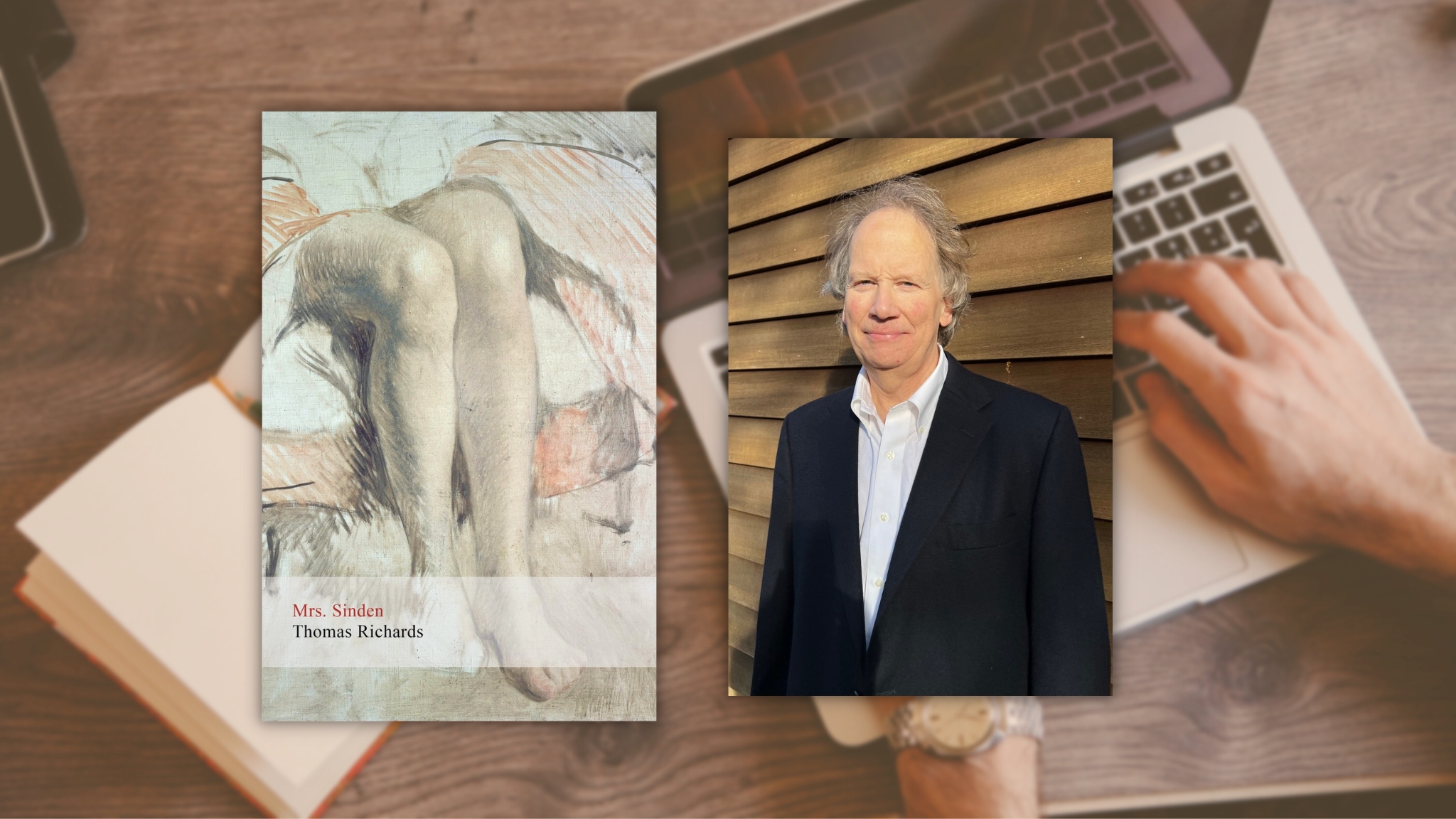Mrs. Sinden by Thomas Richards
To this day, it’s still hard to imagine that a book entitled Memoirs of a Geisha was written by a man (Arthur Golden). The same for Oldest Living Confederate Widow Tells All (Allan Gurganus).
Those two authors, whose books debuted near the turn of the past century, were hardly the first to cross the gender gap as men writing in first person as a female character.
Now add to that list the newly launching Mrs. Sinden (Global Collective Publishers) by Thomas Richards, a former English and American Literature and Language Associate Professor at Harvard and winner of a Guggenheim Fellowship.
Mrs. Sinden is a story of love in a time of plague. Jessica Sinden, a reserved British woman who has lost one of her three children to suicide, unexpectedly falls in love. Love upends her, and even she is surprised by all the changes she feels in and around herself.
But Jessica meets her American lover, Philip Nye, just as rumors begin to mount about some kind of new disease in China. The references to the disease, SARS, are at first offhand and casual, deepening in seriousness as the narrative proceeds, and the two of them wind up quarantined together on a high mountain, waiting for death.
In a recent interview, the author discussed his decision to write a novel in the voice of a woman.
Q: In Mrs. Sinden, you zoom in very closely to main character Jessica Sinden’s mind and heart, progressively revealing new aspects of her as seen through the eyes of other characters as the story unfolds. How did you, a man, channel her voice and essence in such vivid and credible detail?
A: Through her use of language, and through a careful building of interiority.
Language first. Her husband uses language evasively and is preoccupied with little puns. Her son uses it for idle amusement. Her lover is prone to aesthetic abstraction. But Jessica Sinden has a woman’s ability to accommodate speech to facts and emotional realities. This does not mean she is good at relating to people. She begins the novel is a severely unconnected state. But it means she is open to experience and what it will teach her. From the very beginning, she has something about her that very few people have, a strength of seeing that serves her well and a precision of expression, which, though not wholly accurate, has the virtue of being unerringly precise — which is the very wellspring of her development in the book.
As to her inner life, I tried to give Jessica Sinden an almost alarming self-consciousness. She has a strange and severe purity of self-examination, the sense of an intelligence examining itself with an almost embarrassing directness. Cold as she may be at first, Jessica Sinden has the immediate appeal of absolute honesty. It’s what makes her so appealing to Philip Nye. She sees everything she sees with a force that is a kind of inerrancy. Part of why people think of her is cold is that she is so honest with them, though, for the most part, she saves her most ruthless honesty for the people closest to her — her children, her husband, her best friend and her lover.
Q: What interested you about writing from a woman’s point of view?
A: I wanted to show a human being changing. I think that women are better at this than men. My father became more rigid as he got older. My mother opened her mind and became more liberal, more loving, more inquiring. This is a pattern I have seen many times over, and since I wanted to take a 59-year-old as the subject for my novel, I knew my central character would have to be a woman.
I also deal with her gender in part by having her play nearly all of the conventional gender roles very badly. She is a failure as a wife, a mother, and at taking on the conventional attributes of femininity. This does not at all prevent her from being concerned with how she looks, how she dresses or how her hair is being done. But it shows you what kind of woman she is by being unafraid of breaking the usual stereotypes of the feminine. She acts as a woman but not like a woman.
Q: Did the process of writing a female main character change you at all?
A: I began to get much better at hearing and appreciating ambivalence. One of the sentences in the novel I like best is not a sentence at all, but a look at ambivalence as an experience and the hesitancy this can lead to: “No, well, yes, I mean, still, somewhat.”
I’d often heard women I know express themselves in similar ways, but it took me some time to inhabit the richness of this kind of statement. Think of it: all at the same time, the person saying this — in this case, my character Jessica Sinden — is disagreeing, agreeing, expressing uncertainty, qualifying herself and changing her mind! I love the multiple layers of thought and emotion statements like this reveal, and I hear women making them often.
What you take away is not so much a thought as a sentiment about a state of mind. Going after the vagaries of those states is what I learned most from working with a central woman character. Through the process of discovering this, I also learned to be a better listener and pay much closer attention to women — and to men.


Publish Date: January 31, 2023
Author: Thomas Richards
Page Count: 264 pages
Publisher: Global Collective Publishers
ISBN: 9781954021976

































